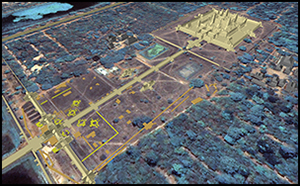Crossref Citations
This article has been cited by the following publications. This list is generated based on data provided by
Crossref.
Fletcher, Roland
Evans, Damian
Pottier, Christophe
and
Rachna, Chhay
2015.
Angkor Wat: an introduction.
Antiquity,
Vol. 89,
Issue. 348,
p.
1388.
Evans, Damian
and
Fletcher, Roland
2015.
The landscape of Angkor Wat redefined.
Antiquity,
Vol. 89,
Issue. 348,
p.
1402.
Stark, Miriam T.
Evans, Damian
Rachna, Chhay
Piphal, Heng
and
Carter, Alison
2015.
Residential patterning at Angkor Wat.
Antiquity,
Vol. 89,
Issue. 348,
p.
1439.
Carter, Alison
Heng, Piphal
Stark, Miriam
Chhay, Rachna
and
Evans, Damian
2018.
Urbanism and Residential Patterning in Angkor.
Journal of Field Archaeology,
Vol. 43,
Issue. 6,
p.
492.
Carter, Alison K.
Stark, Miriam T.
Quintus, Seth
Zhuang, Yijie
Wang, Hong
Heng, Piphal
and
Chhay, Rachna
2019.
Temple occupation and the tempo of collapse at Angkor Wat, Cambodia.
Proceedings of the National Academy of Sciences,
Vol. 116,
Issue. 25,
p.
12226.
Castillo, Cristina Cobo
Carter, Alison
Kingwell-Banham, Eleanor
Zhuang, Yijie
Weisskopf, Alison
Chhay, Rachna
Heng, Piphal
Fuller, Dorian Q.
and
Stark, Miriam
2020.
The Khmer did not live by rice alone: Archaeobotanical investigations at Angkor Wat and Ta Prohm.
Archaeological Research in Asia,
Vol. 24,
Issue. ,
p.
100213.
Moffat, Ian
Klassen, Sarah
Attorre, Tiago
Evans, Damian
Lustig, Terry
and
Kong, Leaksmy
2020.
Using ground penetrating radar to understand the failure of the Koh Ker Reservoir, Northern Cambodia.
Geoarchaeology,
Vol. 35,
Issue. 1,
p.
63.
Kumar, Shashi
Vignesh, S. Kandasamy
Babu, Arun
Thakur, Praveen K.
and
Agrawal, Shefali
2021.
PSInSAR-Based Surface Deformation Mapping of Angkor Wat Cultural Heritage Site.
Journal of the Indian Society of Remote Sensing,
Vol. 49,
Issue. 4,
p.
827.
Klassen, Sarah
Attorre, Tiago
Brotherson, David
Chhay, Rachna
Johnson, Wayne
Moffat, Ian
and
Fletcher, Roland
2021.
Deciphering a Timeline of Demise at Medieval Angkor, Cambodia Using Remote Sensing.
Remote Sensing,
Vol. 13,
Issue. 11,
p.
2094.
Carter, Alison Kyra
Klassen, Sarah
Stark, Miriam T.
Polkinghorne, Martin
Heng, Piphal
Evans, Damian
and
Chhay, Rachna
2021.
The evolution of agro-urbanism: A case study from Angkor, Cambodia.
Journal of Anthropological Archaeology,
Vol. 63,
Issue. ,
p.
101323.
Heng, Piphal
Stark, Miriam T.
Carter, Alison K.
and
Chhay, Rachna
2022.
Form, structure and long-term Angkorian urbanism: A view from the Kok Phnov site (9th–10th century CE).
Archaeological Research in Asia,
Vol. 31,
Issue. ,
p.
100374.
Carter, Alison Kyra
Stark, Miriam T.
Castillo, Cristina Cobo
Heng, Piphal
Zhuang, Yijie
and
Chhay, Rachna
2022.
Prasat and Pteah: Habitation within Angkor Wat's temple enclosure.
Archaeological Research in Asia,
Vol. 32,
Issue. ,
p.
100405.



